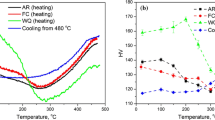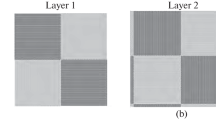Hot isostatic pressing, one of the most promising ways of obtaining high-quality joining of metallic materials, is to be used in the manufacture of permanent joints for the structural elements of fusion reactor installations. However, it can significantly affect the structure and properties of a material. The effect of hot isostatic pressing was investigated on samples of a chromium-zirconium copper alloy selected for the manufacture of individual in-chamber structural elements of fusion reactors. This alloy is preferred because of its enhanced electrical and thermal conduction as well as high strength. The present work is concerned with the effect of temperature, simulating hot isostatic pressing, on the structure and properties of the alloy. The optimal hot isostatic pressing temperature in combination with subsequent heat treatment which afford the necessary physical and mechanical properties of the chromium-zirconium copper alloy was determined.
Similar content being viewed by others
References
G. M. Kalinin, S. A. Fabritziev, B. N. Singh, et al., “Specification of properties and design allowable for copper alloys used in HHF components of ITER,” J. Nucl. Mater., 307–311(1–4), 668–672 (2002).
A. K. Nikolaev and S. A. Kostin, Copper and Heat-resistant Copper Alloys, DPK Press, Moscow (2012).
A. K. Nikolaev, A. I. Novikov, and V. M. Rosenberg, Chromium Bronzes, Metallurgiya, Moscow (1983).
U. Holzwarth, M. Pisoni, R. Scholz, et al., “On the recovery of the physical and mechanical properties of a CuCrZr alloy subjected to heat treatments simulating the thermal cycle of hot isostatic pressing,” J. Nucl. Mater., 279, 19–30 (2000).
A. D. Ivanov, S. Sato, and G. le Marois, “Evaluation of hot isostatic pressing for joining of fusion reactor structural components,” J. Nucl. Mater., 283–287, 35–42 (2000).
U. Holzwarth and H. Stamm, “The precipitation behavior of ITER grade CuCrZr alloy after simulating the thermal cycle of hot isostatic pressing,” J. Nucl. Mater., 279, 31–45 (2000).
N. P. Lyakishev, Handbook of the Phase Diagrams of Binary Metal Systems, Mashinostroenie, Moscow (1996), Vols. 1–3.
M. Li and S. Zinkle, “Physical and mechanical properties of copper and copper alloys,” in: Comprehen. Nucl. Mater, R. Konings (ed.), Elsevier, Amsterdam (2012), Vol. 4, pp. 667–690.
A. A. Suvorova, I. V. Danilov, G. M. Kalinin, and A. B. Korostelev, “Heat treatment effects on the microstructure and properties of Cu–Cr–Zr alloy used for the ITER blanket components,” J. Nucl. Mater. Energy, 15, 80–84 (2018).
Author information
Authors and Affiliations
Corresponding author
Additional information
Translated from Atomnaya Énergiya, Vol. 130, No. 5, pp. 269–273, May, 2021.
Rights and permissions
About this article
Cite this article
Suvorova, A.A., Korostelev, A.B. & Goslavskii, O.V. Hot Isostatic Pressing Temperature Effect on Chromium-Zirconium Copper Alloy Structure and Properties. At Energy 130, 285–289 (2021). https://doi.org/10.1007/s10512-021-00810-y
Received:
Published:
Issue Date:
DOI: https://doi.org/10.1007/s10512-021-00810-y




